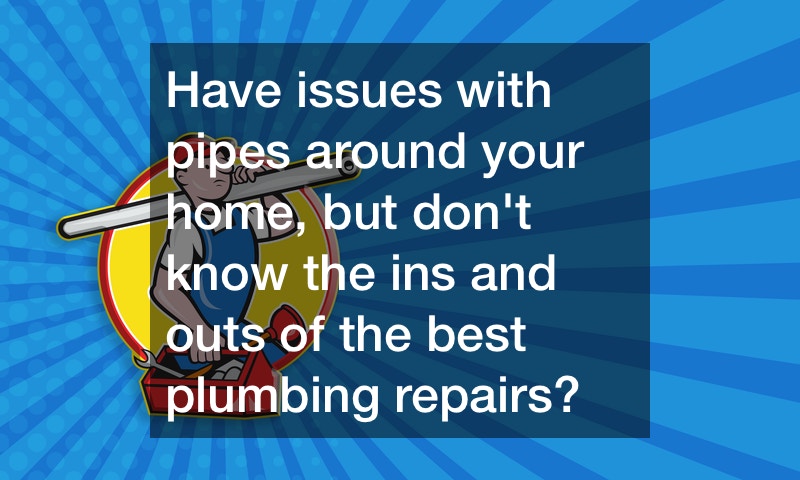
Plumbing Tips to Get You Started


Have issues with pipes around your home, but don’t know the ins and outs of the best plumbing repairs? The website, Car Talk Podcast, offers readers some simple tips for those who are ready to do some serious business plumbing on their own.
Every plumber, professional or not, needs the right tools to get started. To complete plumbing and heating issues, one will need a stainless steel hacksaw, heavy duty stainless steel hose clamps, a hand auger (pipe snake), a pipe wrench, and a basin wrench.
Another helpful word of advice is to know the difference between CPVC and PVC pipes. Hot water runs through CPVC, while PVC hosts cold. CPVC is recommended if you need to replace pipes that attach to your dishwashers or washing machines.
For clogged sinks, remove and check the P trap for any blockages. For constantly running toilets, check the quality of the flapper. Leaky faucet? It might need a replacement aerator or washer. So, before you start web-searching for things like, “plumbing service west palm beach,” or even “best plumbing contractors near me,” keep in mind that fixing your plumbing can be done within the comfort of your own home.
If you have plumbing issues around your house, it can be handy to know how to fix those problems by yourself. Here are a few tips you should know so that you can solve all the minor plumbing issues that arise in your home.

Essential Tools You’ll Need
When thinking about starting in a basic plumbing project, it’s good to have these things on hand.
-
- Heavy duty hose clamps stainless steel necessities. These are essential when attaching a hose onto a valve. There are many types of hose clamps, and they are something most people tend to overlook, but a reliable clamp can make a huge difference. Think of them as the permanent cousin of duct tape; something I know most of us have used to try and fix some of our minor plumbing issues. (I have some under my sink right now.) But, joking aside, invest in heavy duty hose clamps stainless steel will not let you down.
- A trusty stainless steel hacksaw can be used to saw through both metal and plastic pipes. This is handy for making sure you always get the exact length of pipe you need for any job.
- A basin wrench is used for tightening and loosening the nuts that hold most faucets into place. It’s able to reach even hard to get places making your job just a little bit less tedious. A basin wrench is an essential tool to have if your fixing any plumbing around your house.
- A pipe wrench, as the name suggests, is used to loosen pipes and other fittings. One thing to look out for;however, is wearing on the pipes caused by the wrenches serrated jaws, use a piece of cloth to mitigate this.
- A hand auger, more commonly recognized as a plumbing snake, is a hand turned clog clearing tool. This is essential if you ever run into a stubborn clogged toilet, sink, or shower. If a plunger won’t clear it, grab the hand auger.
Basic Tips
Now that you’ve gotten the bare basic tools (don’t forget the heavy duty hose clamps stainless steel is a plumbers best friend!). You’re ready for some basics of standard plumbing.
-
-
- Know the difference between PVC pipes and CPVC pipes. CPVC are used typically for hot water lines, and PVC for cold. CPVC would work well if you are replacing pipes that lead to appliances like washing machines or dishwashers. The measurements of the two are also different. For PVC make sure to measure the diameter inside the pipe itself, whereas CPVC you measure the outside.
- If your trying to fix a clogged sink, check underneath to see if it as a P trap. A P trap is a removable pipe that is 9 out of 10 times the source of the backup. The good news is that it’s a simple fix. Just remove the trap and empty it!
- If you find that your toilet appears to be running around the clock, you can check and see if the flapper has gone bad. A flapper is a rubber bit situated in the back on the toilet. This is an easy fix that will only take you about 10 minutes tops to solve.
- If you have a leaky faucet, you might have a worn aerator; however, it might just need a new washer or rubber seal. Take a minutes to check and see, though all are easy DIY fixes that come with little hassle.
-
Now that you know the basic starter tools that can fix most plumbing issues, and a few tips that can help save time and a few headaches, don’t be afraid to start tinkering around your sink. Most problems have simple fixes, and with a little ingenuity and elbow grease they can be solved in a breeze. (Remember not to forget the heavy duty hose clamps stainless steel is worlds better than duct tape!)